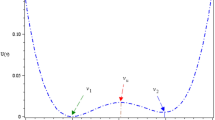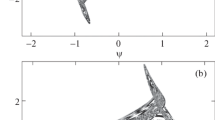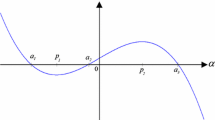Abstract
The effects of colored noise, red noise and green noise, on the onset of chaos are investigated theoretically and confirmed numerically in the generalized Duffing system with a fractional-order deflection. Analytical predictions concerning the chaotic thresholds in the parameter space are derived by using the stochastic Melnikov method combined with the mean-square criterion. To qualitatively confirm the analytical results, numerical simulations obtained from the mean largest Lyapunov exponent are used as test beds. We show that colored noise can induce chaos, and the effects for the case of red noise on the onset of chaos differ from those for the case of green noise. The most noteworthy result of this work is the formula, which relates the chaotic thresholds among red, green and white noise, holds for noise-induced chaos in the Duffing system. We also show that Gaussian white noise can induce chaos more easily than colored noise.







Similar content being viewed by others
References
Sagués, F., Sancho, J.M., García-Ojalvo, J.: Spatiotemporal order out of noise. Rev. Mod. Phys. 79(3), 829 (2007)
Tél, T., Lai, Y.C.: Quasipotential approach to critical scaling in noise-induced chaos. Phys. Rev. E 81(5), 056208 (2010)
Schiff, S.J., Jerger, K., Duong, D.H., Chang, T., Spano, M.L., Ditto, W.L., et al.: Controlling chaos in the brain. Nature 370(6491), 615–620 (1994)
Earn, D.J., Rohani, P., Bolker, B.M., Grenfell, B.T.: A simple model for complex dynamical transitions in epidemics. Science 287(5453), 667–670 (2000)
Crutchfield, J.P., Huberman, B.A.: Fluctuations and the onset of chaos. Phys. Lett. A 77(6), 407–410 (1980)
Crutchfield, J.P., Farmer, J.D., Huberman, B.A.: Fluctuations and simple chaotic dynamics. Phys. Rep. 92(2), 45–82 (1982)
Hirsch, J.E., Nauenberg, M., Scalapino, D.J.: Intermittency in the presence of noise: a renormalization group formulation. Phys. Lett. A 87(8), 391–393 (1982)
Iansiti, M., Hu, Q., Westervelt, R.M., Tinkham, M.: Noise and chaos in a fractal basin boundary regime of a josephson junction. Phys. Rev. Lett. 55(7), 746 (1985)
Liu, Z., Lai, Y.C., Billings, L., Schwartz, I.B.: Transition to chaos in continuous-time random dynamical systems. Phys. Rev. Lett. 88(12), 124101 (2002)
Lai, Y.C., Liu, Z., Billings, L., Schwartz, I.B.: Noise-induced unstable dimension variability and transition to chaos in random dynamical systems. Phys. Rev. E 67(2), 026210 (2003)
Bulsara, A.R., Schieve, W.C., Jacobs, E.W.: Homoclinic chaos in systems perturbed by weak langevin noise. Phys. Rev. A 41(2), 668 (1990)
Frey, M., Simiu, E.: Equivalence between motions with noise-induced jumps and chaos with smale horseshoes. In: Lutes, L.D., Niedzwecki, J.M. (eds.) Engineering Mechanics, pp. 660–663. ASCE, Balkema, Rotterdam (1992)
Lin, H., Yim, S.C.S.: Chaotic roll motion and capsize of ships under periodic excitation with random noise. Appl. Ocean Res. 17(3), 185–204 (1995)
Lei, Y., Fu, R.: Heteroclinic chaos in a josephson-junction system perturbed by dichotomous noise excitation. EPL Europhys. Lett. 112(6), 60005 (2016)
Sivathanu, Y.R., Hagwood, C., Simiu, E.: Exits in multistable systems excited by coin-toss square-wave dichotomous noise: a chaotic dynamics approach. Phys. Rev. E 52(5), 4669 (1995)
Liu, W., Zhu, W., Huang, Z.: Effect of bounded noise on chaotic motion of duffing oscillator under parametric excitation. Chaos Solitons Fractals 12(3), 527–537 (2001)
Song, J.: The harmonic signal dominant frequency change on the behavior of chaotic ocillator dynamics in non-gaussian color noise. J. Am. Chem. Soc. 116(6), 2235–2242 (2010)
Gan, C., Wang, Y., Yang, S., Lei, H.: Noisy chaos in a quasi-integrable hamiltonian system with two dof under harmonic and bounded noise excitations. Int. J. Bifurc. Chaos 22(05), 1250117 (2012)
Gan, C.: Noise-induced chaos and basin erosion in softening duffing oscillator. Chaos Solitons Fractals 25(5), 1069–1081 (2005)
Gan, C.: Noise-induced chaos in a quadratically nonlinear oscillator. Chaos Solitons Fractals 30(4), 920–929 (2006)
Gammaitoni, L., Hänggi, P., Jung, P., Marchesoni, F.: Stochastic resonance. Rev. Mod. Phys. 70(1), 223 (1998)
Lindner, B., Garcıa-Ojalvo, J., Neiman, A., Schimansky-Geier, L.: Effects of noise in excitable systems. Phys. Rep. 392(6), 321–424 (2004)
Maritan, A., Banavar, J.R.: Chaos, noise, and synchronization. Phys. Rev. Lett. 72(10), 1451 (1994)
Pikovsky, A.S.: Comment on chaos, noise, and synchronization. Phy. Rev. Lett. 73(21), 2931 (1994)
Sánchez, E., Matías, M.A., Pérez-Muñuzuri, V.: Analysis of synchronization of chaotic systems by noise: an experimental study. Phys. Rev. E 56(4), 4068 (1997)
Lai, C.H., Zhou, C.: Synchronization of chaotic maps by symmetric common noise. EPL Europhys. Lett. 43(4), 376 (1998)
Lorenzo, M.N., Pérez-Muñuzuri, V.: Colored-noise-induced chaotic array synchronization. Phys. Rev. E 60(3), 2779 (1999)
Wang, Y., Lai, Y.C., Zheng, Z.: Onset of colored-noise-induced synchronization in chaotic systems. Phys. Rev. E 79(5), 056210 (2009)
Rosenstein, M.T., Collins, J.J., De Luca, C.J.: A practical method for calculating largest lyapunov exponents from small data sets. Physica D 65(1–2), 117–134 (1993)
Cveticanin, L., Zukovic, M.: Melnikov’s criteria and chaos in systems with fractional order deflection. J. Sound Vib. 326(3), 768–779 (2009)
Russell, D., Rossing, T.: Testing the nonlinearity of piano hammers using residual shock spectra. Acta Acust. United Acust. 84(5), 967–975 (1998)
Cortopassi, C., Englander, O.: Nonlinear springs for increasing the maximum stable deflection of MEMS electrostatic gap closing actuators. UC Berkeley. http://www-bsac.eecs.berkeley.edu/~pister/245/project/CortopassiEnglander (2009)
Rhoads, J.F., Shaw, S.W., Turner, K.L., Moehlis, J., DeMartini, B.E., Zhang, W.: Generalized parametric resonance in electrostatically actuated microelectromechanical oscillators. J. Sound Vib. 296(4), 797–829 (2006)
Rhoads, J.F., Shaw, S.W., Turner, K.L., Baskaran, R.: Tunable microelectromechanical filters that exploit parametric resonance. J. Vib. Acoust. 127(5), 423–430 (2005)
Van den Broeck, C., Parrondo, J.M.R., Toral, R.: Noise-induced nonequilibrium phase transition. Phys. Rev. Lett. 73(25), 3395 (1994)
Mangioni, S., Deza, R., Wio, H.S., Toral, R.: Disordering effects of color in nonequilibrium phase transitions induced by multiplicative noise. Phys. Rev. Lett. 79(13), 2389 (1997)
Honeycutt, R.L.: Stochastic runge-kutta algorithms. ii. colored noise. Phys. Rev. A 45(2), 604 (1992)
Bao, J.D., Abe, Y., Zhuo, Y.Z.: An integral algorithm for numerical integration of one-dimensional additive colored noise problems. J. Stat. Phys. 90(3–4), 1037–1045 (1998)
Tory, E.M., Bargieł, M., Honeycutt, R.L.: A three-parameter markov model for sedimentation iii. a stochastic Runge–Kutta method for computing first-passage times. Powder Technol. 80(2), 133–146 (1994)
Frey, M., Simiu, E.: Noise-induced chaos and phase space flux. Physica D 63(3), 321–340 (1993)
Lin, H., Yim, S.C.S.: Analysis of a nonlinear system exhibiting chaotic, noisy chaotic, and random behaviors. J. Appl. Mech. 63(2), 509–516 (1996)
Acknowledgements
The authors thank the editor and the anonymous reviewers for their professional suggestions. The work is supported by the National Natural Science Foundation of China (Grant Nos. 11672231 and 11672233), the NSF of Shaanxi Province (Grant No. 2016JM1010), and the Seed Foundation of Innovation and Creation for Graduate Students at the Northwestern Polytechnical University, China (Grant No. Z2017187).
Author information
Authors and Affiliations
Corresponding author
Appendix
Appendix
Here, we will clarify the proposed second-order stochastic Runge–Kutta algorithm for integrating the differential equations under green noise. The basic idea of the algorithm is similar to that in [37] where white or red noise is treated.
We start with formally integrating Eq. (7) from time 0 to time \(\Delta t\) :
Defining
and using the identity [37]
we can expand Eq. (26) about \({z_0}\) to \({(\Delta t)^2}\) . Then, we have
in which \({f_0} = f({z_0})\), and
Then, we get the mean and variance of \({S_z}\) and \({S_\xi }\) to the order of \({(\Delta t)^2}\) :
Parallelly, starting directly from Eq. (7) by using a second-order Runge–Kutta algorithm, we have
in which
and \({\phi _0}\), \({\phi _1}\), and \({\phi _2}\) are three independent standard Gaussian random numbers, each of which has zero mean and unit variance. Expanding Eq. (28) about \({z_0}\) to order \({(\Delta t)^2}\), we obtain
where
The means and the variances of \({S'_z}\) and \({S'_\xi }\) are calculated to be
Equating Eqs. (27)–(29) leads to
Due to the reason that there are three equations and three unknowns, it is possible for us to define a standard Gaussian random number \(\psi \) so that \({\phi _i} = {a_i}\psi ,i = 0,1,2\). To maintain the structure, we can conveniently choose \({a_0} = {a_2} = 1\) and \({a_1} = 0\). Then, these considerations lead to the second-order stochastic Runge–Kutta algorithm as represented by Eq. (10).
Rights and permissions
About this article
Cite this article
Lei, Y., Hua, M. & Du, L. Onset of colored-noise-induced chaos in the generalized Duffing system. Nonlinear Dyn 89, 1371–1383 (2017). https://doi.org/10.1007/s11071-017-3522-1
Received:
Accepted:
Published:
Issue Date:
DOI: https://doi.org/10.1007/s11071-017-3522-1




